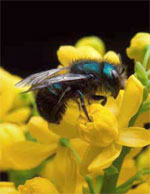 Orchard Mason Bees - September 1, 2010 Jeff Schalau, Associate Agent, Agriculture & Natural Resources University of Arizona Cooperative Extension, Yavapai County Maybe you have seen orchard mason bees available for purchase in your favorite seed catalog and wondered if they would be suitable for your garden or orchard. While I’m not aware of any individuals currently keeping them in Yavapai County, someone probably is doing so, and I think orchard mason bees would be worth trying in the Verde Valley and other areas of north central Arizona. Orchard mason bees (Osmia lignaria) are solitary, pollinating bees. They are slightly smaller than honey bees and are shiny dark blue or almost black in color. Orchard mason bees occur naturally in Arizona and throughout the United States and are only active for a short period of the year. In addition to pollination, they can add interest and beauty to your garden, but they do not produce honey. These gentle bees are not likely to sting, although they will defend themselves if stepped on or trapped under clothing. Orchard mason bees nest in holes in wood. In nature, these can be holes made by borers, grubs, or woodpeckers. Many vendors sell nesting “blocks” and there are several designs (more on this later). The female orchard mason bee visits flowers to collect pollen for her young. She forms a small ball of pollen and nectar in the back of the nesting tube and lays an egg on the ball. Then, she collects mud to form a cell partition and repeats the pollen ball-egg laying process until she reaches the mouth of the tube where she caps the end with mud. Nests built in six-inch deep cavities contain an average of five cells. The female orchard mason bee can control the sex of her offspring and female eggs are typically laid in the innermost cells and male eggs in the outermost cells. A nesting female lives an average of 20 days. During this time, she typically constructs and provisions two to four nests. Under particularly favorable conditions, such as in greenhouses with abundant pollen-nectar resources, six nests totaling 10 female and 20 male cells per nesting female have been documented. In spring, adult males emerge first and wait for the later appearance of the females in order to mate. Their spring emergence makes them an excellent pollinator of many deciduous tree fruits. Orchard mason bees limit their foraging to about 100 yards from the nest which continues for 4-6 weeks before the adults die. During the summer, larvae develop inside the nests, pupate, and the new adults hibernate in the cells over winter. These bees also require some cold temperatures before spring in order to break their dormancy. In nature they nest in beetle galleries in wood. Unlike carpenter bees, mason bees are never destructive to homes or other wooden structures because they do not excavate nest holes themselves. To encourage mason bees you should provide a bee house: the insect equivalent of a bird house. Various designs include wooden blocks drilled with properly sized holes, natural reeds and manufactured straws. The wooden block design lasts a long time but can become infested with bee parasites over time. The straws are more sanitary but require a little more care and protection from weather. In addition, moving the nest during larval development can dislodge the developing bee from its food source and cause it to starve. Visit the Backyard Gardener website for links to more information including nest designs and rearing. Orchard mason bees collect pollen and nectar from a wide array of wild plants, but they show a strong preference for fruit tree flowers when they are available. If their emergence in the spring is not properly timed, having some alternative nectar sources such as dandelions and wildflowers can provide nutrition until crop plants are blooming. To help perpetuate a population of orchard mason bees, you will need pollen-producing plants, adequate nesting structures, a source of mud, and time to monitor and observe their condition during the year. Pesticide use should be minimized or stopped during the orchard mason bee foraging period. Companies that sell orchard mason bees generally ship them during dormancy - between November and March. Also, if you raise orchard mason bees in Yavapai County, I’d like to hear from you and how successful you have been! Naming of companies or products is neither meant to imply endorsement by the author nor criticism of similar companies or products not mentioned. Follow the Backyard Gardener on Twitter – use the link on the BYG website (see link below). If you have other gardening questions, call the Master Gardener line in the Cottonwood office at 646-9113 ext. 14 or e-mail us at cottonwoodmg@yahoo.com and be sure to include your name, address and phone number. Find past Backyard Gardener columns or provide feedback at the Backyard Gardener web site: http://cals.arizona.edu/yavapai/anr/hort/byg/. How to Manage the Blue Orchard Bee (Orchard Mason Bee) www.sare.org/publications/bee/blue_orchard_bee.pdf How to Raise and Manage Orchard Mason Bees for the Home Garden www.ces.ncsu.edu/depts/ent/notes/Other/note109/note109.html Orchard Mason Bees gardening.wsu.edu/library/inse006/inse006.htm Home Orchard Society: Mason Bee Supplies www.homeorchardsociety.org/masonbees/ |